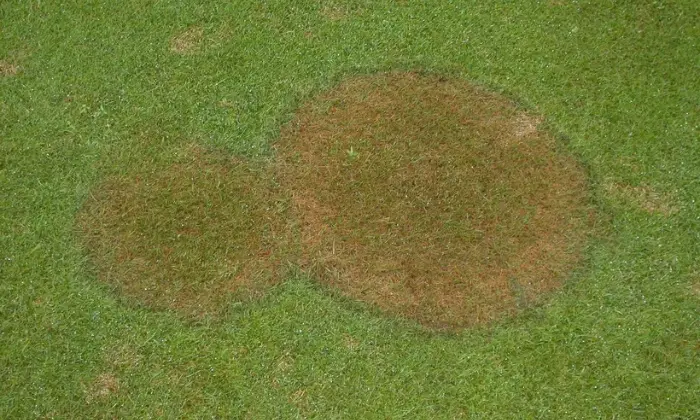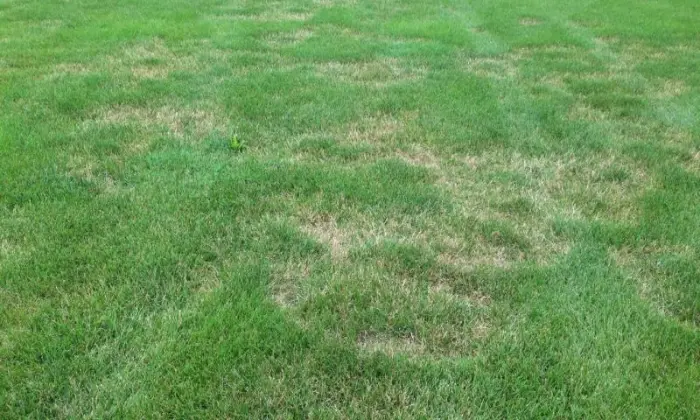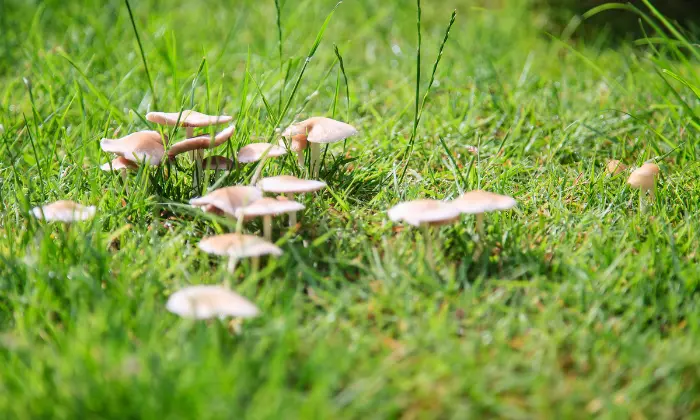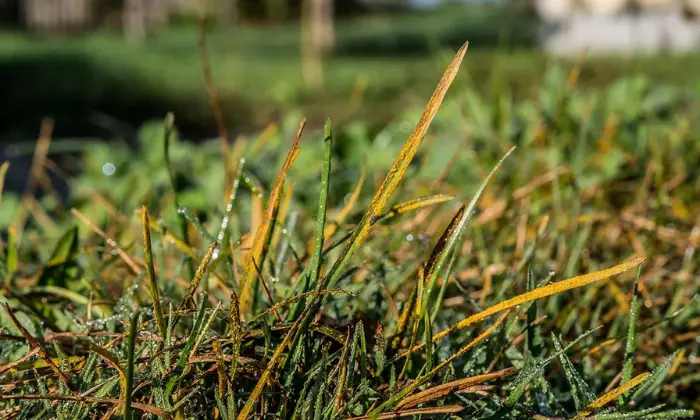Lawn fungus represents a significant challenge for homeowners and landscape professionals, impacting the aesthetic and health of lawns. These fungal infections can manifest as unsightly patches, discoloration, and can even lead to the death of grass if left untreated. Because various types of best lawn fungus treatment, such as brown patch, dollar spot, and powdery mildew, manifest distinct symptoms, they can significantly detract from the overall appearance and vitality of your lawn.
Identifying Lawn Fungus

Identifying lawn fungus early is crucial for effective management and prevention of widespread damage. Common signs of best lawn fungus treatment include discolored patches, wilting, matted grass, and leaf spots. Such as symptoms may appear as brown, yellow, or white patches on the lawn, often exhibiting distinctive shapes like circles or irregular patterns. besides brown patch disease treatment often reveals large, circular brown areas encircled by a darkened ring, whereas dollar spots manifest as small, silver dollar-sized spots with tan centers.
Common Lawn Fungus Diseases
Identifying lawn fungus early is key to preventing widespread damage. Common lawn diseases is the signs of lawn fungus include:
- Discoloured Patches: Irregular patches of brown, yellow, or Best mulch to prevent Weeds.
- Wilting Grass: Areas of the lawn may appear wilted despite adequate watering.
- Matted Grass: Grass blades stuck together, often with a cotton-like appearance.
- Leaf Spots: Circular, water-soaked spots that may turn into brown or yellow lesions.
- Thinning Grass: Areas where the grass is thinning or appears dead.
Types of Lawn Fungus
Lawn fungus type come in various forms, each with its own characteristics and effects on grass health. One common type is fairy rings, which manifest as circular patterns of dark green grass or dead grass, often accompanied by mushrooms. Dollar spot fungus appears as small, round straw-colored patches, while powdery mildew presents as a white, powdery substance on grass blades. Rust fungus causes orange or yellowish-brown pustules on grass blades, leading to thinning and weakening of the lawn.
Dollar Spot
- Appearance: Small, silver dollar-sized spots that can merge into larger patches.
- Conditions: Thrives in warm season, humid weather and is often found on poorly fertilized lawns.
- Signs: Spots of tan or straw-coloured grass with reddish-brown borders.
Brown Patch
- Appearance: Large, circular patches of brown or yellow grass.
- Conditions: Common in hot, humid weather and often affects cool-season grasses.
- Signs: Patches with a smoky or darkened ring, often referred to as a “smoke ring.”
Snow Mold
- Appearance: Circular patches of matted, straw-coloured grass, typically visible after snow melts.
- Conditions: Occurs in cold, wet conditions, particularly under snow cover.
- Signs: White or pink moldy growth on the grass surface.
Powdery Mildew (Blumeria graminis)
- Appearance: White or gray powdery coating on grass blades.
- Conditions: Prefers cool, shaded, and damp environments.
- Signs: Grass appears white or gray and may eventually turn yellow and die.
Best Lawn Fungus Treatment

Treating Best lawn fungus treatment effectively requires a combination of chemical and biological treatments, tailored to the specific type of fungus and the extent of the infestation. Here, we’ll explore the top treatments available, including an in-depth review of Robert’s Complete Care.
Chemical Treatments
Chemical treatments are often the first line of defence against lawn fungus control due to their effectiveness and quick action. Common fungicides include:
Azoxystrobin
- Uses: Broad-spectrum fungicide effective against various fungi including brown patch, dollar spot, and more.
- Application: Typically applied as a spray; follow label instructions for the correct dilution rate and application frequency.
Propiconazole
- Uses: Systemic fungicide that controls a wide range of lawn fungus diseases treatment.
- Application: Absorbed by the grass and moves throughout the plant, providing longer-lasting protection.
Chlorothalonil
- Uses: Contact fungicide effective against leaf spots, dollar spot, and more.
- Application: Requires thorough coverage of the grass for optimal results; often used preventatively.
Myclobutanil
- Uses: Systemic fungicide that prevents and cures a variety of fungal infections.
- Application: Applied as a spray, it provides both curative and preventative action.
Biological Treatments
Biological treatments are increasingly popular due to their environmental friendliness and sustainability. Key options include:
Bacillus subtilis
- Uses: A beneficial bacterium that inhibits fungal growth.
- Application: Often applied as a garden soil drench or foliar spray.
Trichoderma harzianum
- Uses: A beneficial fungus that outcompetes pathogenic fungi.
- Application: Incorporated into the soil or applied as a spray.
Compost Teas
- Uses: Rich in beneficial microbes that enhance soil health and suppress pathogens.
- Application: Applied as a soil drench or foliar spray.
How to Treat Lawn Fungus Naturally

Treating lawn fungus naturally involves using methods and substances that are environmentally friendly, safe for pets and humans, and effective in managing fungal issues without relying on synthetic chemicals. Here are some natural treatment methods, organic fungicides, and home remedies that can help maintain a healthy, fungus-free lawn.
Advantages of Natural Treatments for Lawn Fungus
Natural treatments for lawn fungus control offer several benefits compared to synthetic chemical treatments:
Environmental Safety: Natural treatments are typically non-toxic and biodegradable, reducing the risk of soil and water contamination.
Safety for Humans and Pets: Organic and natural products are generally safer for children and pets that play on the lawn.
Sustainability: Using natural treatments helps promote a balanced ecosystem, encouraging beneficial organisms that support lawn health.
Prevention of Resistance: Fungi are less likely to develop resistance to natural treatments compared to synthetic fungicides, which can lead to more sustainable long-term management.
Soil Health: Many natural treatments enhance soil health by improving its structure and increasing microbial diversity.
Step-by-Step Guide to Natural Treatment
- Mowing: futher Keep your grass at an appropriate height (generally around 2.5 to 3 inches) to promote healthy growth and discourage fungal development.
- Watering: firstly prevents fungal growth, water your lawn deeply but less often, ideally in the early morning. This allows the grass to dry out throughout the day, minimizing the moisture that fungi need to thrive..
- Aeration: Aerate your lawn to improve soil drainage and reduce compaction, which helps grass roots grow stronger and more resistant to diseases.
- Thatch Management: Regularly dethatch your lawn to prevent the build-up of dead grass and organic matter that can harbor fungal spores.
Soil Health Improvement
- Composting: Add compost to your lawn to enhance soil structure and increase beneficial microbial activity, which helps suppress pathogens.
- pH Adjustment: Test and adjust the soil pH to the optimal range for your grass type (usually between 6.0 and 7.0) to promote healthy growth.
Organic Fungicides
- Description: Extracted from the neem tree, neem oil is a natural fungicide with broad-spectrum activity.
- Application: Mix neem oil with water according to the product instructions and spray evenly over the affected areas. Repeat every 7-14 days as needed.
Potassium Bicarbonate
- Description: A naturally occurring compound that alters the pH on the surface of the leaves, making it inhospitable for fungal growth.
- Application: Mix 1 tablespoon of potassium bicarbonate with 1 gallon of water and a few drops of liquid soap. Spray on the affected areas weekly.
Bacillus subtilis
- Description: A beneficial bacterium that inhibits fungal growth and promotes a healthy lawn.
- Application: Apply lawn according to the product label, usually as a soil drench or foliar spray. Use regularly for preventive care.
Home Remedies
- Ingredients: 1 tablespoon baking soda, 1 teaspoon mild liquid soap, 1 gallon water.
- Application: Active ingredients and spray on the affected areas weekly. Baking soda for lawn fungus helps raise the pH on the grass surface, creating an environment less favorable for fungi.
Milk Spray
- Ingredients: 1 part milk (preferably skim), 2 parts water.
- Application: Mix and spray on the affected areas every 10-14 days. Milk contains enzymes and proteins that can act against fungal spores.
Cornmeal
- Description: Cornmeal contains beneficial fungi that outcompete pathogenic fungi.
- Application: Sprinkler cornmeal over the affected areas and water it in. Generally Repeat every few weeks during the growing seasons.
Vinegar Solution
- Ingredients: 1 part white vinegar, 4 parts water.
- Application: Spray lightly on the affected areas, being careful not to oversaturate, as vinegar can be harmful to grass in high concentrations. Use every two weeks.
Best Grass Fungus Treatment

When Choosing the best grass fungus treatment involves considering several key factors, such as effectiveness, safety for pets and children, and environmental impact. Here’s a helpful guide to assist your decision-making.
Choosing the Best Grass fungus Treatment
Choosing the best grass fungus treatment requires careful consideration of several factors to ensure effective management while minimizing potential risks. Firstly, assess the severity and type of fungus in grass affecting your lawn, as different treatments may be more effective against specific strains. Consider the treatment’s effectiveness in controlling a broad spectrum of lawn fungus in grass, as well as its safety for pets, children, and the environment.
Conclusion
In Conclusion, Don’t let lawn fungus ruin your outdoor oasis. With the right knowledge and treatment, you can restore your lawn to its former glory and keep it healthy for years to come. Regardless of whether you choose chemical, biological, or natural remedies, always prioritize safety, effectiveness, and sustainability. And with trusted solutions from Robert’s Complete Care, you can tackle lawn fungus with confidence, knowing that you’re investing in the health and beauty of your lawn. For more information Contact Us today!


